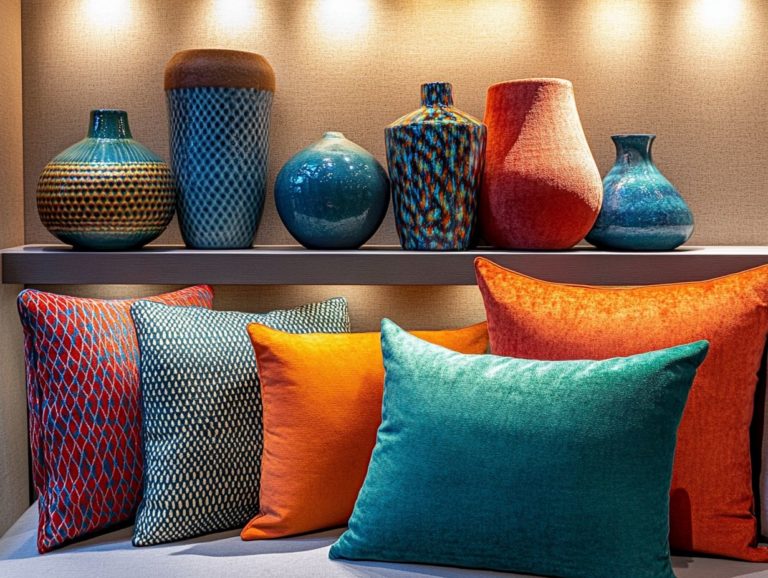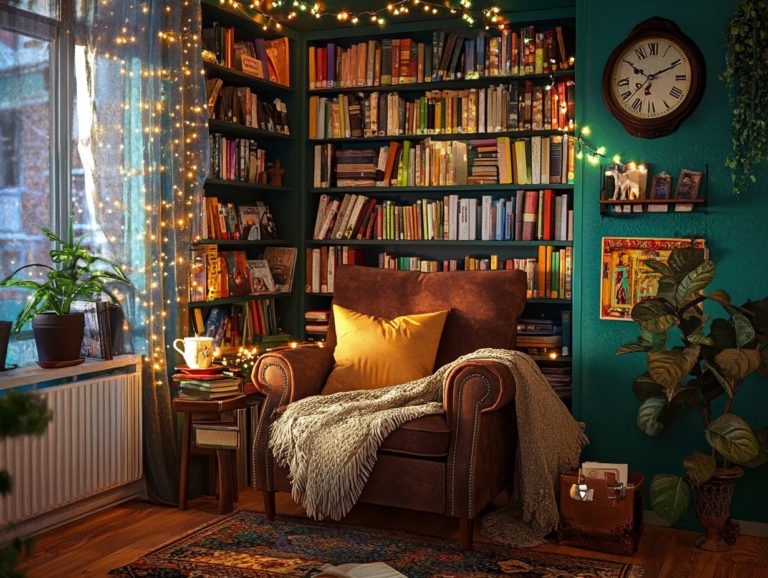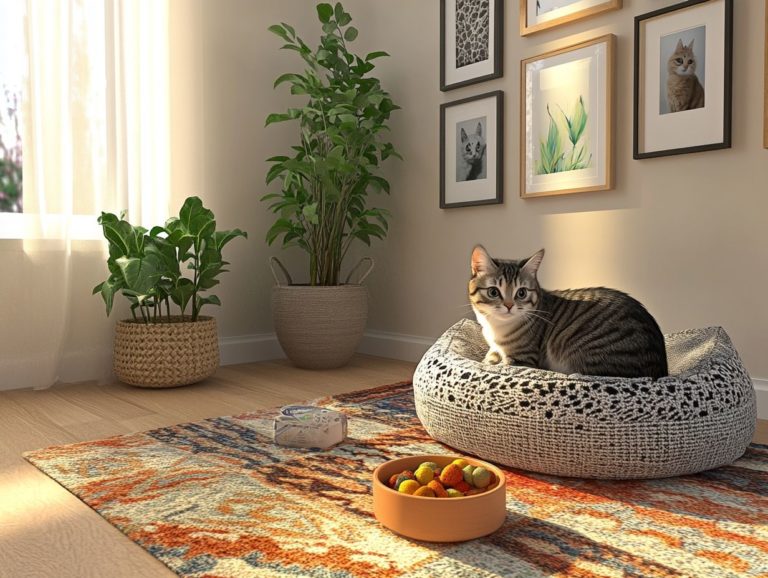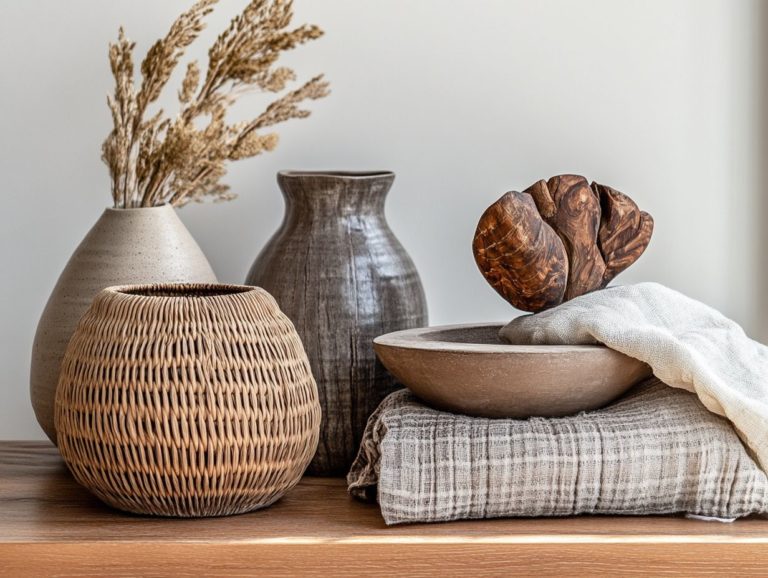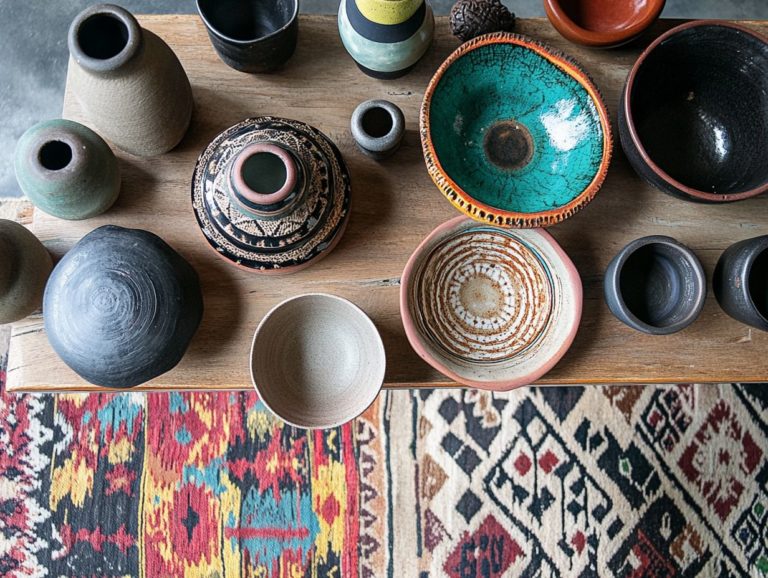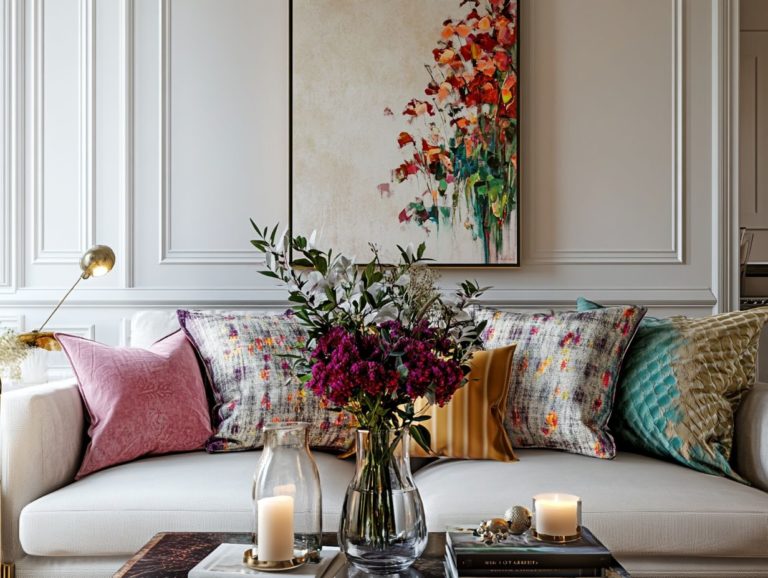The Best Decorative Items for a Zen Atmosphere
Creating a serene and calming environment at home has never been more essential. Transforming your space into a zen sanctuary offers a refuge of tranquility.
This discussion delves into the finest decorative items that nurture a peaceful atmosphere, including indoor plants, natural materials, soft lighting, and minimalist furniture.
Explore how to seamlessly integrate these elements into your home, helping you feel calm and relaxed. Embrace the journey toward a harmonious living space, and watch as your home becomes a true sanctuary.
Contents
- Key Takeaways:
- 1. Indoor Plants
- 2. Natural Materials and Textures
- 3. Soft Lighting
- 4. Minimalist Furniture
- 5. Neutral Color Palette
- 6. Japanese-Inspired Decor
- 7. Water Features
- 8. Incense and Candles
- 9. Zen Art and Calligraphy
- 10. Floor Cushions and Low Tables
- 11. Feng Shui Elements
- 12. De-Cluttered Space
- 13. Natural Scents
- 14. Natural Light
- 15. Mindful Accents
- How to Incorporate These Decorative Items into Your Home
- Frequently Asked Questions
- 1. What are the key elements to creating a Zen atmosphere in a room?
- 2. What are the best decorative items for a Zen atmosphere?
- 3. How can I incorporate natural elements into my Zen atmosphere?
- 4. Can I use traditional Japanese decor for a Zen atmosphere?
- 5. What colors should I use for a Zen atmosphere?
- 6. Can I mix different styles with a Zen atmosphere?
Key Takeaways:
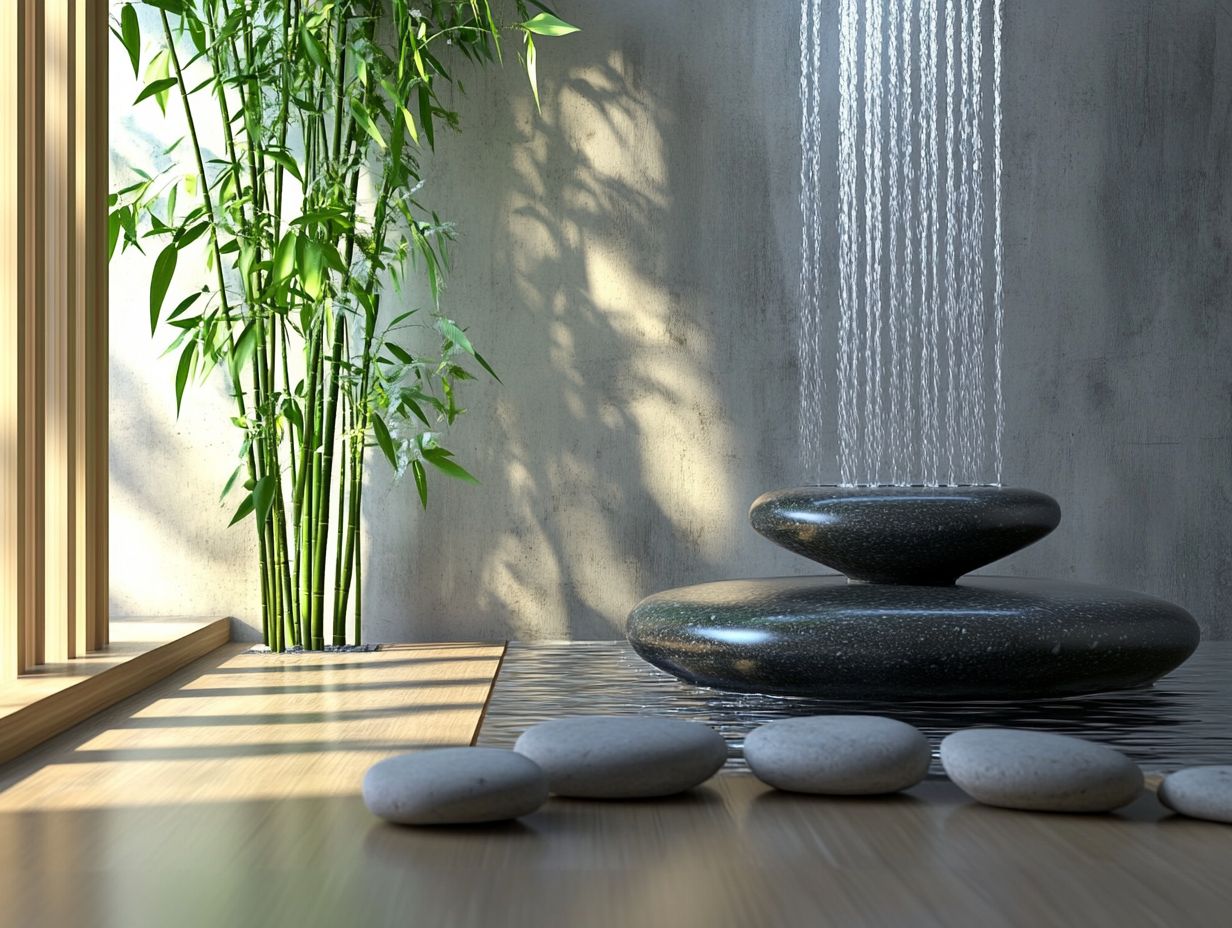
- Introducing indoor plants can add a touch of nature and promote calmness and serenity in a Zen atmosphere.
- Incorporating natural materials and textures, such as wood and stone, can create a sense of harmony and balance in a Zen-inspired space.
- Soft, diffused lighting can create a peaceful and relaxing ambiance in any room, making it a key element in achieving a Zen atmosphere.
1. Indoor Plants
Incorporating indoor plants into your zen room can truly elevate the atmosphere. They create a serene environment that helps you relax while seamlessly blending natural elements into your sacred space.
The advantages of these plants extend far beyond mere aesthetics; they actively purify the air and foster a healthier atmosphere. This is especially beneficial in meditation areas, where clean, fresh air is essential for deep, restorative breathing.
Opt for varieties like peace lilies, snake plants, and pothos. These are not only low-maintenance but also enhance a calming ambiance, perfectly complementing minimalist design principles.
Their lush greenery and distinctive textures instill a sense of tranquility. This allows you to quiet your mind and focus on your inner peace.
2. Natural Materials and Textures
Embracing natural materials and textures in your home design can cultivate a grounding atmosphere that resonates with zen principles. This enhances the calming essence of your meditation space and supports your mental well-being.
By incorporating earthy colors and soft materials, you can foster a serene environment that promotes relaxation and mindfulness.
Shades of terracotta, olive green, and sandy beige create a soothing palette, inviting tranquility into the room. Consider adding elements like reclaimed wood, smooth stones, and breathable textiles, which evoke a sense of nature.
Imagine draping soft cotton or linen fabrics over your seating areas, introducing hand-carved wooden accents, or placing natural stone sculptures in thoughtfully selected spots. These elements harmonize beautifully to create a sanctuary that nurtures your spirit and calms your mind.
3. Soft Lighting
Soft lighting is essential for creating tranquil decor in your zen room. It crafts an inviting ambiance that encourages relaxation and enhances your mindfulness practices.
Incorporating dimmable lights allows you to adjust the brightness to match your mood or activities. This cultivates a space that feels both cozy and adaptable.
Pairing these lights with the gentle flicker of candles introduces warmth and serenity, enriching the overall aesthetic. Strategically placed lamps can highlight specific areas, casting soft shadows that evoke a comforting atmosphere.
When you combine this with calming ambient sounds like soft music or the soothing whispers of nature you create a harmonious interplay of lighting and sound that truly nurtures peace and well-being.
4. Minimalist Furniture
Choosing minimalist furniture is crucial for crafting an organized space that embodies zen principles. This approach creates visual continuity and a clean aesthetic, promoting focus and relaxation.
Incorporating elements like low-profile sofas and sleek tables designed with light fabrics and earthy tones fosters a sense of tranquility that permeates your environment. Warm, creamy beiges, muted greens, and gentle creams enhance the room’s natural light, creating an atmosphere that feels open and inviting.
These choices eliminate distractions and encourage mindfulness, serving as a serene backdrop for meditation and creative pursuits. Positioning modular shelving can further elevate this calming vibe, offering subtle storage solutions without overwhelming the visual space.
5. Neutral Color Palette
A neutral color palette in your zen room promotes color harmony and elevates the calming scents and overall serenity of the space, making it an ideal sanctuary for meditation and mindfulness.
By selecting earthy tones like soft browns, muted greens, and gentle beiges, you can craft a soothing backdrop that encourages relaxation and introspection. These colors mimic the tranquility of nature, fostering a sense of grounding and peace.
To enhance this serene environment, consider incorporating accent colors through decor items such as cushions, throws, or artwork. Shades like soft blues or terracotta beautifully complement the earthy base, adding visual interest without disturbing the tranquil ambiance.
Choose organic materials like wood or stone to maintain harmony, ensuring each piece reflects the peaceful vibe you aspire to cultivate.
6. Japanese-Inspired Decor
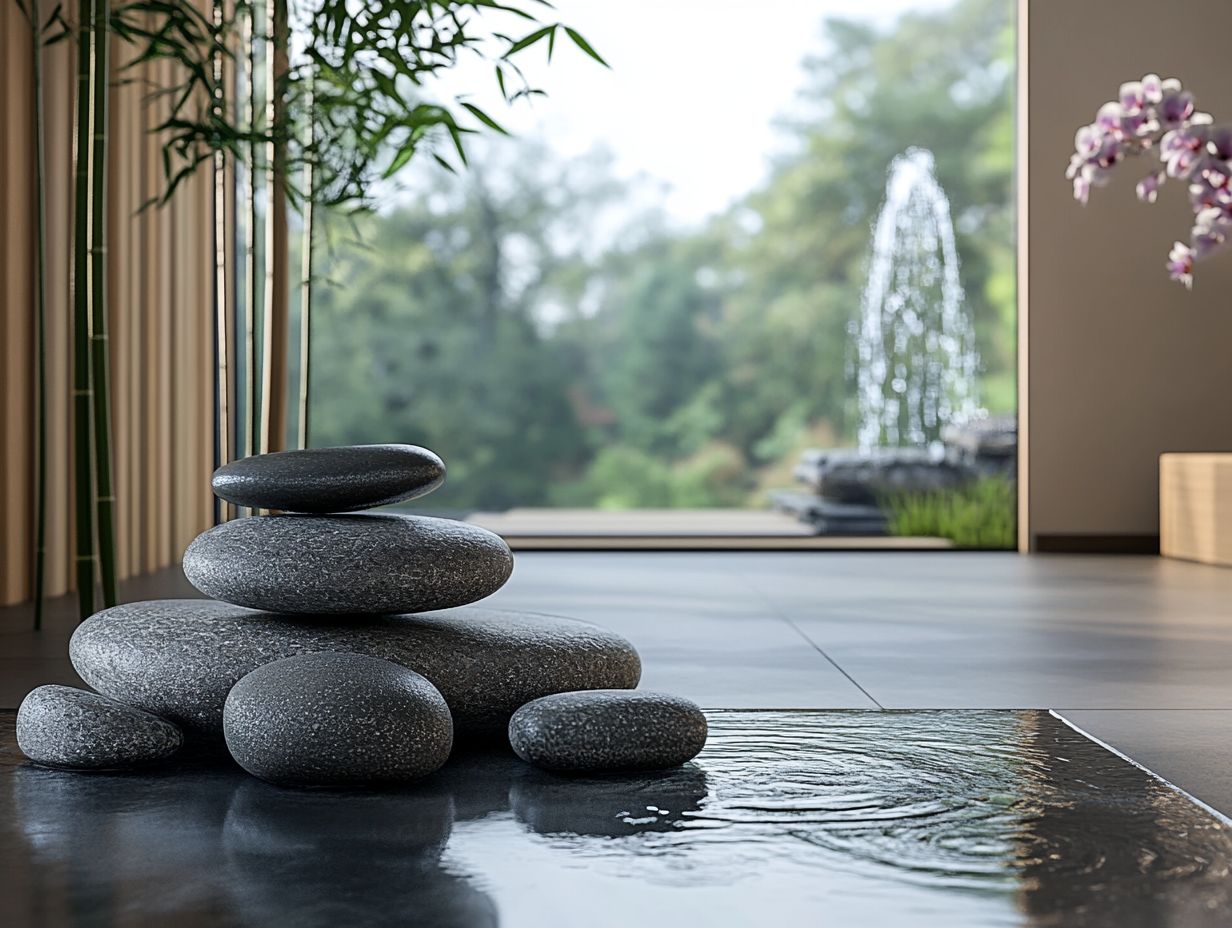
Japanese-inspired decor embodies the essence of zen principles, transforming your space into a tranquil haven that encourages mindfulness and elevates your personal sanctuary.
This decor style is defined by its simplicity, allowing natural materials and forms to take center stage. Emphasizing empty space makes your environment feel open and uncluttered, fostering mental clarity and peace.
To cultivate an authentic zen room, integrate traditional elements like tatami mats, which add warmth and create a tactile connection to nature. Shoji screens serve as elegant dividers, softly filtering light to create a calming atmosphere perfect for relaxation and introspection.
Adding these elements instantly brings harmony to your space, transforming your room into a true sanctuary.
7. Water Features
Incorporating a soothing water feature into your zen room significantly elevates the relaxing atmosphere, offering ambient sounds that foster tranquility and enhance your relaxation techniques.
Consider the elegance of an indoor fountain, where water trickles gently, or the captivating movement of aquarium fish. Each water feature you choose engages both sight and sound in a harmonious embrace.
Indoor fountains provide visual pleasure, filter the air, and add essential humidity, while aquariums introduce vibrant colors and lively motion, inviting a sense of balance into your space.
When thoughtfully integrated into your zen decor, these elements transform any corner into a peaceful retreat, guiding your mind toward serenity. They become focal points that encourage mindfulness and reflection, enriching your environment and nurturing your well-being.
8. Incense and Candles
Incorporating incense and candles in your zen room elevates your sensory experience, enveloping the air with calming scents that foster relaxation and mindfulness while harnessing the principles of aromatherapy.
Among the many options, sandalwood incense stands out for its grounding properties, making it an excellent companion for meditation. Meanwhile, lavender candles emit a soothing aroma that gently calms your mind after a long day. Herbal incense, like sage or jasmine, introduces unique fragrances that invite serenity into your space.
The soft flicker of candlelight, paired with these aromatic choices, crafts a tranquil atmosphere where you can unwind, reflect, and connect with your inner calm, transforming each meditation session into a restorative sanctuary.
9. Zen Art and Calligraphy
Incorporating zen art and calligraphy into your decor elevates your space, inspiring positive emotions and deepening your connection to mindfulness.
Select pieces that embody simplicity, harmony, and balance to create a serene atmosphere. A calligraphy piece with quotes about nature serves as a daily reminder of your values. Wall hangings with serene landscapes or minimalist ink drawings resonate with zen principles, encouraging calm.
Choosing artworks that align with these tenets integrates seamlessly into any setting, nurturing a peaceful mindset and inviting personal growth.
10. Floor Cushions and Low Tables
Using floor cushions and low tables can turn your zen room into an inviting oasis that promotes comfort and relaxation.
This arrangement enhances the visual allure of the space and fosters mindfulness and community among those who gather. Lower seating encourages deeper engagement with your surroundings and meaningful connections with others.
To achieve a serene ambiance, use natural materials like bamboo or organic cotton for warmth. Soft colors and uncomplicated patterns enhance the calming effect, making your space a true sanctuary for reflection and social connection.
11. Feng Shui Elements
Adding Feng Shui elements to your zen room enhances energy flow and cultivates tranquility.
Thoughtfully arrange furniture, select calming colors, and integrate natural materials for a peaceful environment. Position larger items to allow easy movement, ensuring that pathways remain clear.
Pair shades of blue and green with earthy textures like wood or stone for a soothing visual experience. Adding plants purifies the air and connects your space with nature, grounding energy and promoting calm.
12. De-Cluttered Space
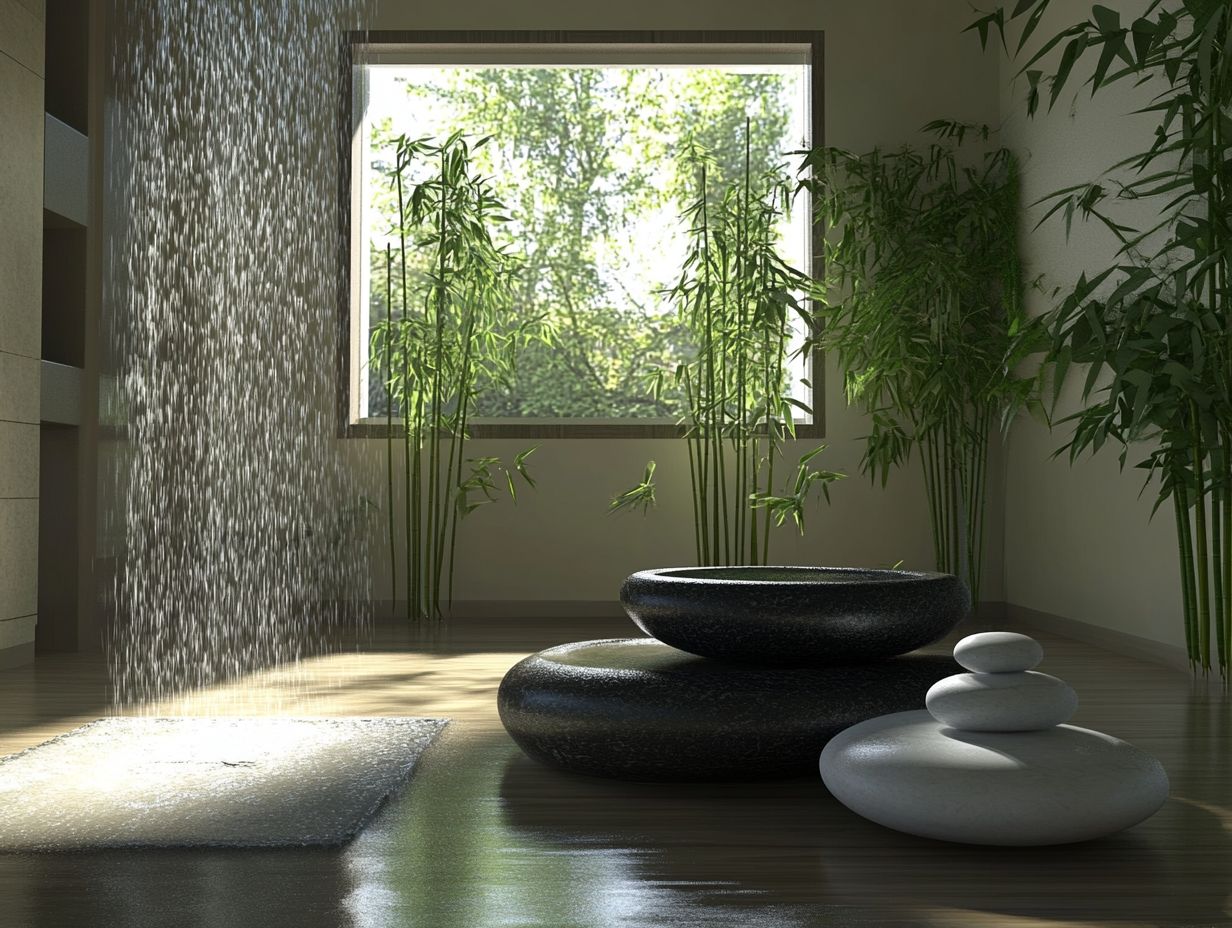
Keep your space clutter-free to feel great and think clearly! Maintaining a de-cluttered space is essential for embracing zen principles.
Consciously limit excess items to foster tranquility and focus. Recognizing the significance of negative space allows your eyes to rest and creates an inviting atmosphere for deep reflection.
To declutter effectively, evaluate each item’s utility and sentimental value, keeping only what serves a purpose or sparks joy.
Choose decor that harmonizes functionality with aesthetics, like stylish storage solutions that blend with your space’s theme, balancing beauty and practicality.
13. Natural Scents
Integrating natural scents into your zen room transforms it into a sanctuary of peace, enhancing your meditation experience.
Select essential oils and incense that embody tranquility like lavender, chamomile, and sandalwood to create a serene atmosphere. Each scent has unique properties that help reduce stress and foster calm.
The soothing aroma of eucalyptus invigorates the mind, while bergamot uplifts your spirits, creating harmony. Burning incense like frankincense or myrrh deepens your connection to inner peace, allowing for profound meditation.
Experimenting with these aromas personalizes your space and enhances relaxation and emotional well-being. Start creating your zen space today!
14. Natural Light
Maximizing natural light in your zen room creates visual continuity and helps foster a sense of openness and calm. Both are essential for effective relaxation techniques and meditation practices.
This blend uplifts your spirits and creates a tranquil atmosphere. Let sunlight into the room, and you’ll see how it brightens the space and lifts your mood!
To amplify these benefits, position your sofa or meditation cushions near the windows to bask in glorious sunlight during your practice. Strategically placing mirrors can reflect light and create a more vibrant ambiance. Opting for decor in lighter tones will further illuminate the area, transforming it into a true sanctuary of serenity.
15. Mindful Accents
Incorporating mindful accents into your zen room elevates your decor while serving as gentle reminders of mindfulness, creativity, and the emotional triggers that nurture your self-care practices.
When you select thoughtful decor items like soothing art pieces showcasing serene landscapes or calming abstract designs you enhance your space and cultivate an atmosphere that invites relaxation.
Soft cushions in natural fabrics and earthy tones beckon you to sink in and linger, encouraging precious moments of reflection.
Adding plants like peace lilies and snake plants not only purifies the air but also embodies the zen principle of harmony with nature.
Each of these elements harmonizes beautifully, creating a cohesive sanctuary that fosters tranquility and inspires deeper mindfulness in your daily rituals.
How to Incorporate These Decorative Items into Your Home
Incorporating decorative items that embody zen principles can transform your space into a sanctuary for relaxation and self-care, promoting a calming and inspiring atmosphere.
To achieve this, select decor pieces that resonate with your personal journey and values think handcrafted ceramics or natural materials like bamboo and stone. Thoughtfully arrange these elements to elevate the serene vibe. Mixing textures and forms creates visual interest and aligns beautifully with the zen aesthetic.
The key is to curate a collection that feels authentic to you. This fosters a tranquil environment that encourages mindfulness. Adding greenery, such as small indoor plants, further connects your space to nature, infusing life and freshness into your decor.
Frequently Asked Questions
1. What are the key elements to creating a Zen atmosphere in a room?
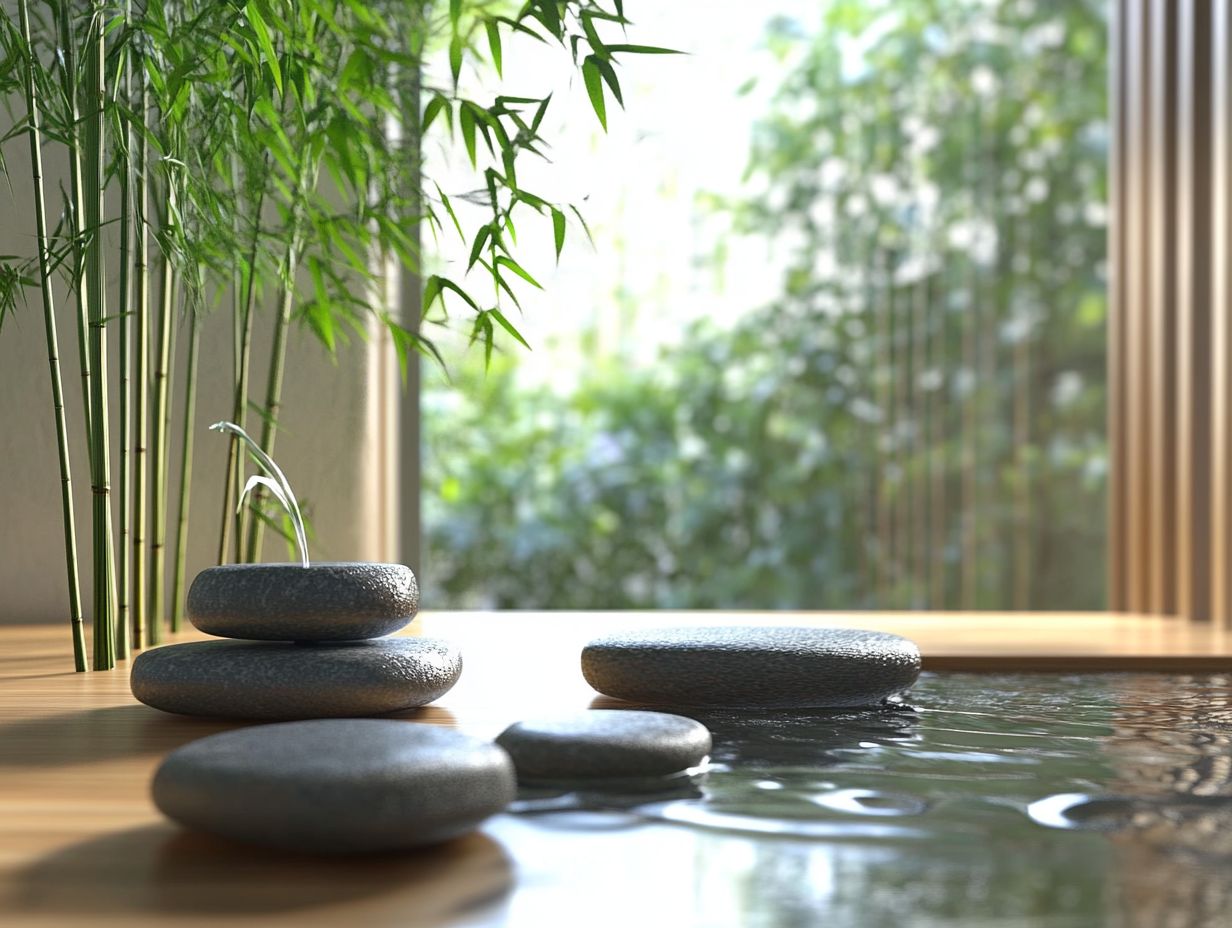
To create a Zen atmosphere, focus on simplicity, natural elements, and a sense of calmness. Achieve this through minimalistic decor, natural materials, and soothing colors.
2. What are the best decorative items for a Zen atmosphere?
The best decorative items for a Zen atmosphere include bamboo plants, Japanese lanterns, meditation cushions, and water fountains. For a deeper understanding of how these items influence your space, check out the role of decorative items in Feng Shui. These items bring in natural elements and promote tranquility.
3. How can I incorporate natural elements into my Zen atmosphere?
You can incorporate natural elements by using materials such as wood, bamboo, stone, and natural fibers for your furniture and decor. Adding plants, rocks, and water features brings in a sense of nature.
4. Can I use traditional Japanese decor for a Zen atmosphere?
Yes! Traditional Japanese decor, such as shoji screens, tatami mats, and bonsai trees, are excellent additions to a Zen atmosphere. They introduce a cultural aspect and promote simplicity and balance.
5. What colors should I use for a Zen atmosphere?
For a Zen atmosphere, it’s best to stick to neutral and earthy tones like beige, cream, brown, and green. These colors promote calmness and harmony with nature.
6. Can I mix different styles with a Zen atmosphere?
Yes! You can mix different styles with a Zen atmosphere, as long as they follow key elements of simplicity, natural elements, and calmness. For example, mixing minimalistic and bohemian styles can create a unique and tranquil space.

